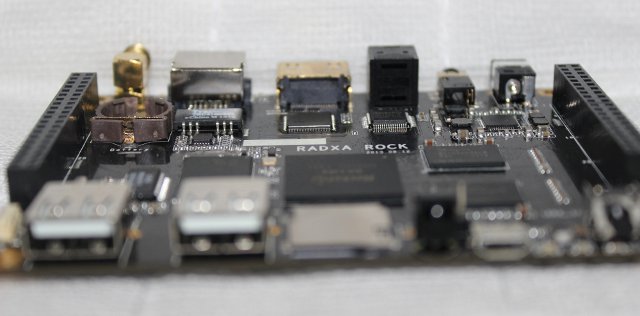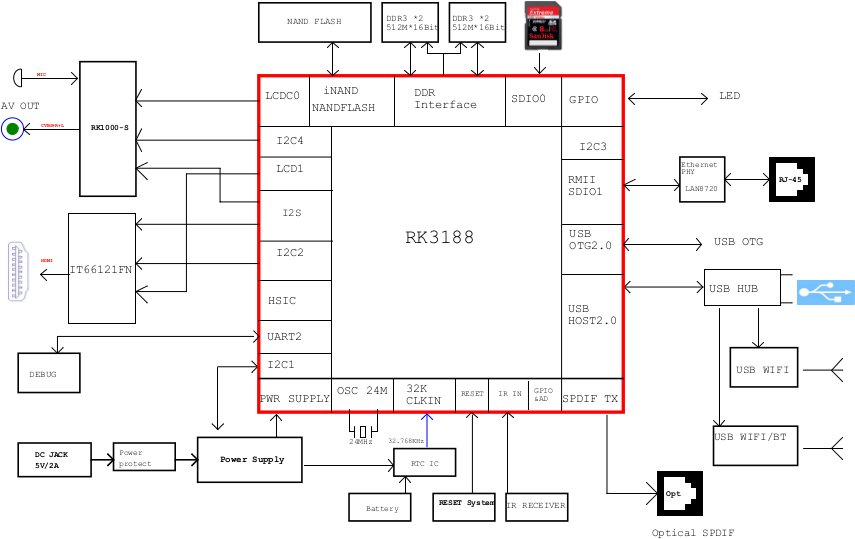As previously mentioned, work was in progress to design development boards based on Rockchip processors. Radxa Rock and Radxa Rock Lite, 2 boards powered by Rockchip RK3188, are now available to early developers, and the final versions will soon be broadly available.

Here are the boards specifications:
- SoC – Rockchip RK3188 ARM Cortex-A9 quad core @ 1.6Ghz + Mali-400 MP4 GPU
- System Memory – 2GB DDR3 @ 800Mhz (1GB DDR3 @ 800Mhz for Lite version)
- Storage – 8GB Nand Flash (4GB Nand Flash for Lite version) + micro-SD SDXC up to 128GB
- Video Output – HDMI 1.4 up to 1080p@60hz, andAV output
- Connectivity:
- 10/100M Ethernet port
- WIFI 150Mbps 802.11b/g/n with antenna
- Bluetooth – Bluetooth 4.0 (Not in Lite version)
- Audio I/O – Audio S/PDIF, headphone jack
- USB – 2x USB 2.0 host port, micro USB OTG
- Debugging – Serial Console
- Misc – IR sensor, power key, recovery key, reset key, 3 LEDs, RTC
- Expansions Header -80-pins including GPIO, I2C, SPI, Line in, USB 2.0, PWM, ADC, LCD, GPS… etc

The boards will support both Android and Linux. The latter with limitations such as lacking video hardware acceleration (VPU), at least until some workaround (libhybris?) are found. The early schematics (PDF) can also be downloaded for reference.
There are currently 100 working samples that early developers can acquire for half price now. The final retail is not fully confirmed, but I’ve been told Radxa Rock should go for $89, and Radxa Rock Lite for $69, which look like decent prices.
You can find more information and pre-order (register interest) on radxa.com.

Jean-Luc started CNX Software in 2010 as a part-time endeavor, before quitting his job as a software engineering manager, and starting to write daily news, and reviews full time later in 2011.
Support CNX Software! Donate via cryptocurrencies, become a Patron on Patreon, or purchase goods on Amazon or Aliexpress





Is this $89 price correct or half or full price?
If it is final sale price then it seems like really good value. I wonder what it would cost them to add a clear case with small rubber feet.
They have a horrible website, such items always seem to lose out on marketing efforts.
Really difficult to understand their website…
Provide schemathics is really good! But I always ask, can Radxa buyers learn how to design RK3188 based boards.
Even I feel interested on buying one of them, but the lack of information from their website stops me.
@Belta99 That sounds like the ‘simple case’ Tom did for the Cubieboard, which I think costs about $4. I hope they offer the same with this.
@anyone For someone who doesn’t need GPIO etc, will these offer any advantages over existing RK3188 TV sticks or STBs? (Which I’d guess would be available in 2GB/8GB flavour for ~$60 shipped by the time these boards come out…)
Very nice, would had been way cleaner way to build my cluster… Oh well, things advance.
At least that board seem to use USB-based WiFi chipsets, too bad no specifications public yet, just marketing PR that plagues all those Chinese product specifications listings.
Only real problem I see, that there is no obvious mounting for an heatsink, maybe they plan some of those nasty glue-on uglies, or worse yet, active cooling in it?
Nevertheless, cool product, that goes into the very short list of suggestible ARM boards, like the Odroid boards.
I think Olimex or Cubie have something in the pipeline for the Rockchip.
@John This one is Cubie’s…
A question to the masters (thera are more than one here…)
Is design a RK3188 based board so “simple” as look from schematics?
Simple is not a word used in setting up a pcb. Only simple part of board is the ground.
Of course, that is why I said “””””simple”””””. But I’m not an ingineer and can understand almost all in those schematics. I never tried to program an ARM SOC, I don’t know if recomendable to start with something like this.
“Development board”, but this is for develop what, hard? soft? both? Do these development boards provide documentation? For develop hard or soft?
Sofar they are working on the documentation and say they will ship this week with or with out documents is unsure.
First off should help with the software development and once full documents are shown could also lead to hardware as you can add your own devices and components to sockets and compile your own drivers much like the main idea of the ras Pi amlogic.
Once your sure you have it how you like you can send the layout to a factory and have them do some R&D and 100K+ down the road Javi android/linux stick can be born
@anon
Looks like they might ship with heatsinks on the CPU:
http://cubieboard.org/2013/09/01/2-in-1-heatsink-package-for-cubies/
I just noticed these support micro SD up to 128GB! So why do RK3188 tablets only support 32GB?
Why are most of these boards missing SATA ports?
They’d be ideal to build your own lil low power storage server!
USB only is lame.
Lack of support for external battery is a major drawback for me with the majority of these boards. Pity the cubietruck has been so delayed, hope something better comes in in the not to distant future.
Actually I don’t need 100K+, at the end of last year I found that a i.MX6Q Android TV Stick can be made (1000pcs production) for under 50K including third party board design, my own designed plastic case (including moulding), packing and so on.
If I just want to make that “Javi’s Android stick” always can use rapid prototyping and board samples. Not cheap… but amazing.
Every service can be easy found here in Shenzhen. Anyway I like “create”, that is why I want to learn about this.
I just found they are in shenzhen, but this is all the info:
Radxa is a hardware startup founded in Shenzhen, China in 2013.
From the map it looks like they are in CheGongMiao, just 5 subway stations from my home. And the phone number (002) 050-2219-665 I never saw something similar…
I pity they don’t give enough information.
I really would like a place (website or forum) for talking about this kind of boards design. I think between some people something good can be made.
@Touko Agreed, but I don’t think most of the common ARM CPUs (/chipsets?) support SATA (or USB3). (Anyone know if the next generation support USB3 at least?)
@Javi Did you see the CNX article about 4GB RAM RK3188 sticks? If RK3188 can indeed support 4GB RAM, I think there’d be a niche market for those. (Slightly disappointed no 4GB Radxa Rock is in the works…)
@Javi
The creators of Radxa are the same guys as of Cubieboard and upcoming Cubietruck. You can find Tom Cubie – a guy from this company, if not its CEO on #linux-rockchip IRC channel at freenode. His nickname is hipboi.
Can you reply this message? I’d like to get in touch with you.
@arokux
I’m in touch woth Tom by email… later I back here and comment a bit more
Well, it looks like they want to make this big step by step.
Samples will be improved (hardware changes) so they are selling 100pcs half price now.
I’m really interested about learning, if they provide hard and soft info it’s a good board I think.
No Sata is a huge miss.
@Javi can we get in contact in some ways?
@Javi I would like to talk with you, can you share your email?
Tom Cubie said “RK3188 doesn’t support SATA, and there is no other high speed bus that can support sata, usb to sata is slow.”
@Passante
@arokux
Just add the skype: asiapads
I’m there
After some days still don’t know if buy or not this board…
Should be shipping soon; does anyone know where to find package lists for the linux distros available on the Radxa?
(& Tom 你怎么没做四gb的了? :p)
Articles on booting Linux (& NAS performance with USB2) here:
http://hwswbits.blogspot.com/2013/10/booting-linux-on-radxa-rock.html
From a reliable source we current know that Tom Cubie is not longer working at CubieTech. With current Radxa launch it seems obvious.
Radxa Rock now officially selling from Miniand: https://www.miniand.com/products/Radxa%20Rock%20Dev%20Board
@Jacob Ritzema
He is the owner of CubieTech. I guessed he just made another company called Radxa under the same roof. I’ve seen people to do that in China and Hong Kong.
Maybe good to do a quick comparison of this & Odroid-U3? (Especially if someone can get both :p)
@onebir
It looks like I’ll get the Radxa board, but probably not ODROID-U3.